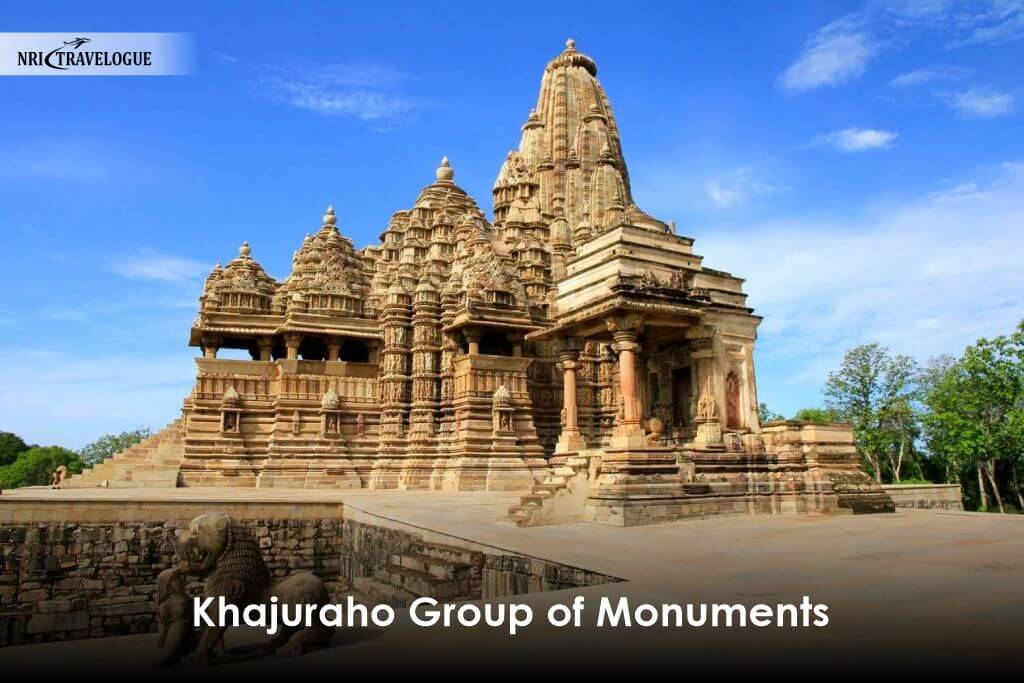Located in the centre of Khajuraho, Madhya Pradesh, the Matangeshwar Mahadev Mandir is one of the oldest and most respected temples dedicated to Lord Shiva. It was built between 900 and 925 CE by the Chandela kings. This temple is special among the Khajuraho Group of Monuments because it is the only one still used for regular worship today. At the heart of the temple is a large Shiva Lingam, about 8.5 feet tall, made from smooth yellow sandstone, which attracts many devotees.
Unlike the other temples in Khajuraho that are full of detailed carvings, this temple is simple in design. This shows the early style of architecture, making it a rare mix of history and spirituality. For people coming to India, whether for faith or travel, this temple gives a peaceful and holy experience.
Historical and Mythological Significance
The Matangeshwar Mahadev Mandir holds a rich historical and mythological legacy. Constructed during the reign of Chandela king Harshadeva, the temple is believed to house a Shiva Lingam named after the sage Matanga, who is said to have manifested as the lingam to control the god of love.
According to local legend, the lingam is considered a “living” Shiva Lingam, growing incrementally each year, particularly on Sharad Purnima. Priests and tourism officials reportedly measure its height annually, noting an increase equivalent to the size of a sesame seed. Mythology also ties the temple to a precious gem, the Markand Mani, believed to have been buried beneath the lingam for safekeeping, adding to its mystique. This blend of history and legend makes the temple a significant pilgrimage site.
Architectural Highlights
Unlike the intricately carved Khajuraho temples, the Matangeshwar Mahadev Mandir is known for its minimalist design. The temple is a square structure, approximately 35 feet by 35 feet, with a simple entrance on the eastern side. Its multi-storeyed shikhara (tower) and square sanctum sanctorum reflect early Chandela architectural styles.
The massive Shiva Lingam, standing 8.5 feet tall with a 4-foot circumference, is the temple’s centrepiece, made of polished yellow sandstone that gleams under the temple’s dim lighting. A small Ganesha statue adorns the upper right corner, and a depiction of a goddess with attendant deities is visible en route to the sanctum. The temple’s simplicity and spiritual aura make it a striking contrast to the more ornate neighbouring temples like the Kandariya Mahadev and Lakshmana temples.
Spiritual Importance
The Matangeshwar Mahadev Mandir is a vibrant centre of worship, especially during festivals like Maha Shivratri and the month of Sawan. Devotees flock to offer water, milk, and bel leaves to the Shiva Lingam, accompanied by chants of “Om Namah Shivay” and the ringing of bells. The temple’s active worship status sets it apart from other Khajuraho monuments, which are primarily historical sites.
The serene atmosphere, filled with the scent of incense and the sound of Sanskrit chants, creates a deeply spiritual experience. For pilgrims, the temple is believed to grant blessings of peace, prosperity, and spiritual liberation, making it a must-visit for those seeking divine connection.
Best Time to Visit
The ideal time to visit the Matangeshwar Mahadev Mandir is between October and March, when Madhya Pradesh enjoys pleasant weather with temperatures ranging from 10°C to 25°C.
This period is perfect for exploring Khajuraho’s outdoor attractions comfortably. Maha Shivratri, typically in February or March, is a particularly vibrant time, with the temple adorned with flowers and lights, and special rituals attracting thousands of devotees.

The Sawan month (July–August) is also significant, though the monsoon season may bring rain and humidity. Avoid visiting during the scorching summer months (April–June), as temperatures can exceed 40°C, making outdoor exploration challenging.
How to Reach Matangeshwar Mahadev Mandir
1. By Air
Khajuraho has a domestic airport, approximately 5 km from the temple, with direct flights from major cities like Delhi, Mumbai, and Varanasi. Airlines such as Air India, IndiGo, and SpiceJet operate regular flights. From the airport, a taxi or auto-rickshaw can take you to the temple in about 15 minutes.

2. By Train
Khajuraho Railway Station, located 1 km from the temple, is well-connected to cities like Delhi, Bhopal, Jaipur, and Varanasi. Major trains include the Uttar Pradesh Sampark Kranti and the Khajuraho Express. From the station, a short auto-rickshaw or taxi ride will bring you to the temple.

3. By Road
Khajuraho is accessible via well-maintained roads from nearby cities like Bhopal (380 km), Gwalior (280 km), and Jhansi (175 km). The nearest bus stand is Chhatarpur, 45 km away, but taxis or private cabs are recommended for convenience. Buses from major cities like Delhi and Bhopal also connect to Khajuraho. For a hassle-free journey, book a private taxi, especially if visiting during peak pilgrimage seasons.

Temple Timings and Entry
The Matangeshwar Mahadev Mandir is open daily from 6:00 AM to 10:00 PM, allowing ample time for darshan and exploration. Entry to the temple is free, though donations for rituals or prasad are welcome but not mandatory.
The temple is located just south of the Lakshmana Temple and outside the Archaeological Survey of India (ASI) compound, making it easily accessible. Photography is permitted outside, but visitors are advised to check with priests before taking photos inside the sanctum.
Rituals and Offerings
Devotees typically perform abhishekam (ritual bathing of the Shiva Lingam) with water, milk, or honey, and offer bel leaves, flowers, and sandalwood paste. The temple priests conduct daily aarti ceremonies, with morning and evening sessions being the most attended.
During Maha Shivratri, special rituals include Rudrabhishek and night-long prayers. Visitors can purchase puja thalis (offering plates) from nearby shops, though the temple provides basic facilities like water for offerings. The atmosphere during these rituals, filled with chants and incense, is deeply immersive.
Nearby Attractions
1. Khajuraho Group of Monuments
The Matangeshwar Mahadev Mandir is part of the Western Group of Temples, a UNESCO World Heritage Site. Nearby, the Kandariya Mahadev Temple, known for its intricate erotic carvings, and the Lakshmana Temple, dedicated to Lord Vishnu, are must-visit. These temples, built between 950 and 1050 CE, showcase the architectural brilliance of the Chandela dynasty.

2. Raneh Falls
Located 20 km from Khajuraho, Raneh Falls is a scenic waterfall on the Ken River, offering a refreshing break amidst nature. The nearby Ken Gharial Sanctuary is ideal for wildlife enthusiasts.

3. Panna National Park
About 40 km from Khajuraho, this national park is home to tigers, leopards, and diverse flora. A half-day safari can complement your temple visit with an adventure in the wild.

4. Dhubela Museum
Located 60 km from Khajuraho, this museum houses artefacts from the Chandela era, including sculptures and weapons, offering insights into the region’s history.

Accommodation Options
Khajuraho offers a range of accommodation options to suit different budgets:
- Luxury Hotels: High-end hotels near the Western Group of Temples provide modern amenities and proximity to the Matangeshwar Mahadev Mandir, ideal for a comfortable stay.

- Mid-Range Hotels: Budget-friendly hotels and resorts offer clean rooms and basic facilities, located within 1–2 km of the temple.

- Guest Houses and Homestays: Affordable options for pilgrims, often with a homely atmosphere and local hospitality.

- Dharamshalas: Basic accommodations for devotees, located near the temple, offering simple rooms at minimal cost.

Book in advance during Maha Shivratri or Sawan to secure a spot, as accommodations fill up quickly.
Local Cuisine and Dining
Khajuraho offers a variety of dining options, from local Madhya Pradesh cuisine to North Indian and continental dishes. Try local delicacies like bhutte ka kees (corn-based dish), dal bafla, and poha. Restaurants near the temple serve vegetarian meals, ideal for pilgrims. Popular dining spots include rooftop cafes with views of the temple complex and street food stalls offering samosas, jalebis, and lassi. Ensure food hygiene by choosing reputable eateries, especially during the monsoon season.

Travel Tips for Visitors
- Dress Modestly: Wear respectful clothing, covering shoulders and knees, especially during temple visits.
- Stay Hydrated: Carry water bottles, particularly in summer, as Khajuraho can get hot.
- Hire a Guide: A local guide can enhance your understanding of the temple’s history and mythology.
- Beware of Monkeys: The temple area may have monkeys; secure food items and valuables.
- Cash and Cards: Carry some cash for small purchases, as not all shops accept digital payments.
- Respect Rituals: Follow temple etiquette, such as removing shoes and maintaining silence during prayers.
Festivals and Events
The Matangeshwar Mahadev Mandir comes alive during Maha Shivratri, with grand celebrations, including night-long prayers and cultural performances. The Sawan month sees devotees offering water to the Shiva Lingam daily. The Khajuraho Dance Festival, held annually in February, is a cultural highlight nearby, featuring classical dance performances against the backdrop of the temples. Plan your visit around these events for a richer experience.
Safety and Accessibility
The temple is safe for visitors, with local police and ASI staff ensuring security. The site is accessible for most, though the sanctum involves a few steps, which may be challenging for those with mobility issues.
Wheelchair access is limited, so inform the temple management in advance for assistance. Women travellers should feel comfortable, but are advised to travel in groups or with a guide after dark, especially in less crowded areas.
Why Visit Matangeshwar Mahadev Mandir?
The Matangeshwar Mahadev Mandir offers a unique blend of spirituality, history, and cultural heritage. Its active worship status, combined with the legend of the growing Shiva Lingam, makes it a compelling destination for devotees.
For history enthusiasts, its connection to the Chandela dynasty and UNESCO World Heritage status adds allure. The temple’s serene setting, coupled with Khajuraho’s other attractions, makes it an ideal stop for those exploring Madhya Pradesh. Whether you seek divine blessings or a glimpse into India’s ancient past, this temple promises a memorable visit.
Conclusion
The Matangeshwar Mahadev Mandir is more than a place of worship; it’s a living testament to India’s spiritual and architectural heritage. Its massive Shiva Lingam, historical significance, and active devotional practices make it a must-visit in Khajuraho. With easy access, nearby attractions, and a range of accommodation and dining options, planning a trip to this sacred site is straightforward.
Whether you’re a pilgrim seeking blessings or a traveller exploring India’s cultural treasures, this temple offers an enriching experience that resonates long after your visit. Plan your journey today to discover the divine and historical charm of the Matangeshwar Mahadev Mandir.









